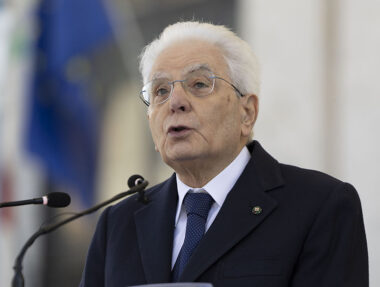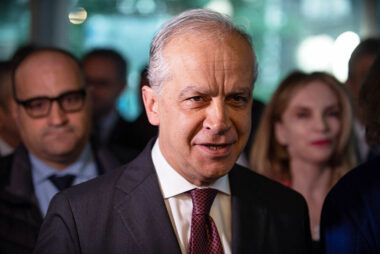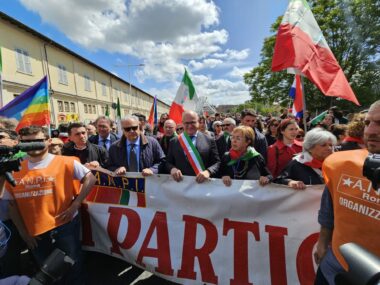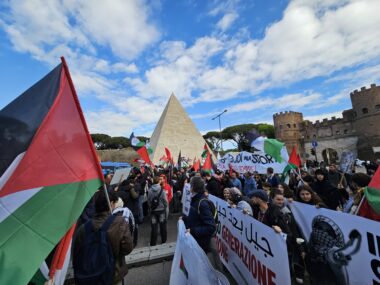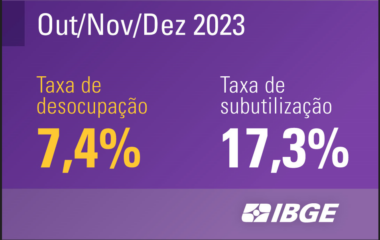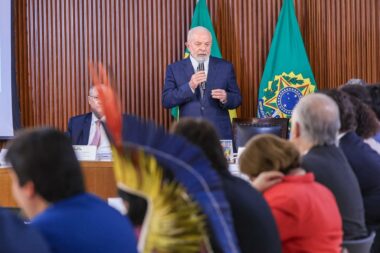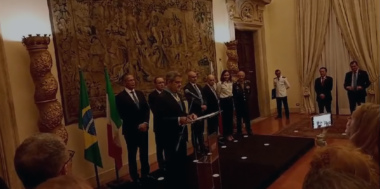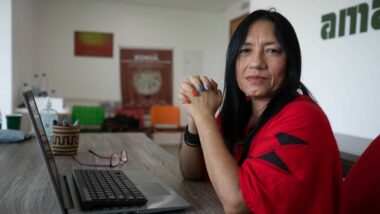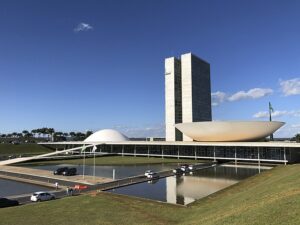Ferrogrão Railway divides opinions of logistics experts and defenders of indigenous peoples
In an interview with Dire agency, the director of FGV Transportes Marcus Quintella evaluated that the railway construction project is of great impact for the country's logistics
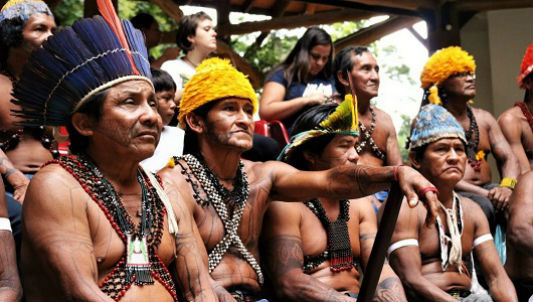
by João Marcelo
SAO PAULO – In the middle of March, the minister of the STF (Superior Federal Court), Alexandre de Moraes, suspended the environmental licensing of the Ferrogrão railroad after an injunction from the PSOL (Socialism and Freedom party). The minister accepted the argument that the route planned for the railway would cut Jamanxim National Park, a protected forest located in Pará. In addition to reducing the perimeter of the forest, the railway would also pass over indigenous lands.
With an estimated investment of R $ 12 billion, the Ferrogrão project provides for 933 kilometers of tracks, connecting the city of Sinop in Mato Grosso to Miritituba, on the banks of the Tapajós River, in Pará. The government has already declared that it intends to hold the auction at the end of this year. The notice is being analyzed by the Federal Audit Court.
The execution of the project divides opinions, both by professionals in the field and economists, as well as by indigenous leaders and organizations that work in favor of the rights of the traditional peoples of Brazil. In an interview with Dire agency, the director of FGV Transportes (Center for Transport, Logistics and Urban Mobility Studies at the Getúlio Vargas Foundation), Marcus Quintella evaluated that the railway construction project has a great impact on the country’s logistics, taking into account considering that currently all the production in the region that will be served by the railroad needs to be transported by trucks to the southeast and south of the country. “Certainly, it has a fantastic logistical characteristic for the country that will divide the logistical flows of the North arc and will continue to descend to Santos distributing the flow, as it should be done. Now its economic viability will depend on many factors, so it is not yet a very clear situation in terms of viability for the investor and it is up to the government to show society its socio-environmental viability ”, explained Quintella.
One of the questions raised by Quintella is the common concession model proposed by the government. A Common Concession is the delegation, by means of a contract, of providing a public service to a private company for a specified period, in the case of the Ferrogrão railway, the term is 69 years, under specific conditions outlined by the federal government. The concessionaire makes the necessary investments and assumes the risks of operating the activity, remunerating itself through the collection of fees from users.
The basic difference between Public-Private Partnership and Common Concession is the remuneration of the private partner. “Simple concession, today in terms of railroad is very complicated. The simple concession must have a lot of attractiveness and a lot of proven demand for companies to simply invest and know that the entire operation will pay off. In addition, the company will pay the grant ”. The teacher explained
The director also argues that more demand studies need to be carried out on the spot and that the analysis provided by the government alone is not enough to attract investors. “The investment values are being evaluated initially, close to 10 billion reais to make the railroad, and over the years there would be another billions for maintenance. Apart from that, the government says that the railway will have a nominal capacity of 40 million tons. The estimated demand for 2030 would be 21 million tonnes and 2060 48.6 million tonnes. This is theoretically raised and demand studies are officially offered by the government. No investor will start from this premise, it is impossible. I’ve been on this side of the counter and you would never work with that hypothesis ”. Completed.
On the other hand, institutions that defend indigenous peoples and indigenous leaders themselves already show dissatisfaction with the project. As is the case with the Indigenous Missionary Council (CIMI). The council is part of the CNBB (National Conference of Bishops of Brazil) and interviews with Dire agency the coordinator of CIMI Norte 2, which operates in the Pará region, Haroldo Espírito Santo, said that he does not trust the government’s discourse that the project does not it will severely impact communities, in addition Haroldo fears that the Munduruku community will be the most affected. “This information that is going to be outside the margin of indigenous lands is not true, and one of the peoples that is most persecuted and affected by illegal logging and illegal mining, which are the Munduruku, will be the most affected by this railroad. If this work goes forward, the impacts will be very large and not only for indigenous peoples, but for the entire riverside population, ”said Espírito Santo.
Another factor that is not pleasing to the defenders of traditional peoples is the lack of dialogue between public authorities and indigenous leaders. For the coordinator of CIMI norte 2, the dialogue must respect the will of the Munduruku people who have their own consultation protocol. “Every population that is going to be affected, directly or indirectly, by some public enterprise has the constitutional right to be heard. The Munduruku people have their consultation protocol that took time to be created and that protocol was officially presented in Brasilia ”.
According to Haroldo, there were attempts at dialogue between the government and the Munduruku, but this was done within the parameters of the government, without respecting the wishes of the indigenous people. “In the middle of a pandemic, they wanted to take the village leaders to take them to Brasília to simply inform what would be done. Is this how the government thinks it will consult? That way it will not happen, the Munduruku are very faithful to their choices and decisions ”.
Espírito Santo also said that if the government does not respect the rights of indigenous peoples, the Munduruku will not passively accept it. “I guarantee you that the Munduruku and the other affected peoples will not accept this with their arms crossed, they will talk, which is always the first step, they will confront and claim their rights so that the project does not happen in the way that the government wants ”. He stressed.
IN BRASILE SOSPESO IL PROGETTO FERROGRAO: TAGLIA LE TERRE INDIGENE
by João Marcelo
SAN PAOLO DEL BRASILE – La licenza ambientale per la ferrovia Ferrograo, una nuova arteria lunga 933 chilometri, è stata sospesa a seguito di un ricorso presentato dal Partido Socialismo e Liberdade (Psol). Alexandre de Moraes, ministro della Corte federale suprema (Superior Tribunal Federal, Stf), ha accettato la tesi secondo cui la ferrovia attraverserebbe un’area forestale protetta, il Parco nazionale Jamanxim, nello Stato di Parà, riducendone la superficie e toccando anche terre delle comunità native.
Il progetto Ferrograo prevede 933 chilometri di binari, con un investimento stimato di 12 miliardi di reais (pari a 1,77 miliardi di euro), dalla città di Sinop nel Mato Grosso a Miritituba, sulle rive del fiume Tapajos, nel Parà. Il governo ha comunicato che intende tenere l’asta per assegnare la realizzazione del progetto ai privati entro fine anno. L’annuncio è all’esame della Corte dei conti federale. L’esecuzione del piano infrastrutturale però divide l’opinione pubblica: da un lato, i professionisti del settore e gli economisti; dall’altro, i leader nativi e le organizzazioni che lavorano a favore dei diritti dei popoli tradizionali del Brasile.
In un’intervista con l’agenzia Dire, il direttore del Centro per gli studi sui trasporti, la logistica e la mobilità urbana della Fondazione Getulio Vargas (Fvg), Marcus Quintella, evidenzia che la ferrovia può avere “un impatto fantastico” per la logistica, dato che oggi tutte le merci viaggiano verso il sud-est e il sud del Paese su camion. “Dividerà i flussi dell’arco nord e continuando verso Santos, a sud, distribuendo il flusso nel modo migliore”. Secondo il direttore, d’altra parte, “la sua sostenibilità economica dipenderà da molti fattori, quindi non è ancora una situazione molto chiara in termini di redditività per l’investitore e spetta al governo mostrare alla società la sua sostenibilità socio-ambientale”.
Quintella sottolinea inoltre che è necessario condurre ulteriori esami sulla domanda in loco e che lo studio fornito dal governo da solo non è sufficiente per attirare gli investitori.
“Si stanno valutando le cifre di investimento inizialmente vicine ai 10 miliardi di reais per realizzare la ferrovia e negli anni dovrebbero arrivare altri miliardi per la manutenzione” dice il direttore. “A parte questo, il governo stima che la ferrovia sarà in grado di movimentare 40 milioni di tonnellate di merci.
La domanda stimata per il 2030 sarebbe di 21 milioni di tonnellate e nel 2060 arriverà a 48,6 milioni di tonnellate.
Nessun investitore vorrà partire con queste premesse. Sono stato ‘dall’altro lato del tavolo’ e so che nessuno vuole lavorare così”.
D’altra parte, le istituzioni che difendono le popolazioni indigene e gli stessi leader nativi mostrano già insoddisfazione per il progetto. È ad esempio il caso del Consiglio missionario indigeno (Cimi). Il Consiglio fa parte della Conferenza episcopale del Brasile (Cnbb). Haroldo Espirito Santo, coordinatore del Cimi Norte 2, che opera nella regione del Parà, sottolinea in un’intervista con la Dire che sebbene il governo dica che il progetto non avrà un particolare impatto sulle comunità, questo non sarebbe vero e che invece quella di Munduruku sarà tra le comunità più colpite. “Il fatto che si sostenga che la ferrovia passerà al di fuori dei confini delle terre indigene semplicemente è falso, e proprio uno dei popoli più perseguitati e colpiti dal disboscamento e dall’estrazione illegale, sarà anche il più colpito da questa ferrovia” dice Espirito Santo. “Se il progetto andrà avanti le conseguenze negative saranno molto ampie e non solo per le popolazioni indigene ma anche per la comunità lungo il fiume”.
Un altro elemento che non piace ai difensori dei popoli tradizionali è la mancanza di dialogo tra autorità pubbliche e rappresentanti dei nativi. Secondo il coordinatore di Cimi Norte 2, si deve tener conto della volontà del popolo Munduruku. “Ogni comunità che sarà direttamente o indirettamente interessata dai progetti pubblici ha il diritto riconosciuto dalla Costituzione di essere ascoltata e il popolo Munduruku ha il suo meccanismo di consultazione che ha richiesto tempo per essere creato ed è stato presentato ufficialmente a Brasilia”.
Secondo l’attivista, ci sono stati tentativi di dialogo tra il governo e il Munduruku, ma questo è stato fatto entro i parametri del governo, senza rispettare i desideri degli indigeni. “Nel bel mezzo di una pandemia volevano portare i leader del villaggio a Brasilia per informarli di cosa sarebbe stato fatto” accusa il coordinatore del Cimi Norte 2. “È così che il governo pensa di consultarli? In questo modo non accadrà.
I Munduruku sono molto fedeli alle loro posizioni”.
FERROVIA FERROGRÃO DIVIDE OPINIÕES DE ESPECIALISTAS DE LOGÍSTICA E DEFENSORES DIREITOS DOS POVOS INDÍGENAS
por João Marcelo
Ferrovia Ferrogrão divide opiniões de especialistas de logística e defensores dos povos indígenas
por: João Marcelo
SAO PAULO – Em meados do mês de março, o ministro do STF (Superior Tribunal Federal), Alexandre de Moraes, suspendeu o licenciamento ambiental da ferrovia Ferrogrão após liminar do PSOL (Partido Socialismo e Liberdade). O ministro acatou o argumento de que o traçado previsto para a ferrovia cortaria o Parque Nacional do Jamanxim, uma floresta protegida localizada no Pará. Além de reduzir o perímetro da floresta, a ferrovia também passaria por cima de terras indígenas.
Com investimento estimado em R$12 bilhões, o projeto da Ferrogrão prevê 933 quilômetros de trilhos, ligando a cidade de Sinop no Mato Grosso a Miritituba, nas margens do Rio Tapajós, no Pará. O governo já declarou que pretende fazer o leilão no fim deste ano. O edital está em análise no Tribunal de Contas da União.
A execução do projeto divide opiniões, tanto por parte de profissionais da área e economistas quanto de lideranças indígenas e de organizações que atuam a favor dos direitos dos povos tradicionais do Brasil. Em entrevista à agência Dire, o diretor da FGV Transportes (Centro de Estudos em Transportes, Logística e Mobilidade Urbana da Fundação Getúlio Vargas), Marcus Quintella avaliou que o projeto de construção da ferrovia é de grande impacto para a logística do país, tendo em vista que atualmente toda a produção da região que será atendida pela ferrovia precisa ser transportada por caminhões até o sudeste e sul do país. “Certamente ela tem uma característica logística fantástica para o país que vai dividir os fluxos logísticos do arco Norte e vai continuar descendo para Santos distribuindo o fluxo, como deve ser feito. Agora a viabilidade econômica dela dependerá de muitos fatores, então não é uma situação ainda muito clara em termos de viabilidade para o investidor e cabe ao governo mostrar para a sociedade a sua viabilidade socioambiental”, explicou Quintella.
Um dos questionamentos levantados por Quintella é o modelo de concessão comum proposto pelo governo. Uma Concessão Comum é a delegação, por meio de um contrato, da prestação de um serviço público a uma empresa privada por prazo determinado, no caso da ferrovia Ferrogrão o prazo é de 69 anos, sob condições específicas delineadas pelo governo federal. A concessionária faz os investimentos necessários e assume os riscos da exploração da atividade, remunerando-se por meio da cobrança de tarifas junto aos usuários.
A diferença básica entre Parceria Público-Privada e Concessão Comum é a remuneração do parceiro privado. “Concessão simples, hoje em termos de ferrovia é muito complicado. A concessão simples tem que ter muita atratividade e muita demanda comprovada para as empresas simplesmente investirem e saberem que toda a operação vai ter retorno. Além disso, a empresa pagará outorga”. Explicou o professor
O diretor ainda argumenta que precisam ser realizados mais estudos de demanda no local e que só a análise fornecida pelo governo não é suficiente para atrair os investidores. “Os valores de investimento estão sendo avaliados inicialmente perto de 10 bilhões de reais para fazer a ferrovia, e ao longo dos anos existiriam outros bilhões para manutenção. Fora disso, o governo diz que a ferrovia terá uma capacidade nominal de 40 milhões de toneladas. A demanda estimada de 2030 seria de 21 milhões de toneladas úteis e 2060 48,6 milhões de toneladas úteis. Isso aí é teoricamente levantado e são estudos de demanda oferecidos oficialmente pelo governo. Nenhum investidor vai partir dessa premissa, é impossível. Eu já estive deste lado do balcão e você nunca iria trabalhar com essa hipótese”. Completou.
Por outro lado, instituições que defendem os povos originários e as próprias lideranças indígenas já demonstram insatisfação com o projeto. Como é o caso do Conselho Indigenista Missionário (CIMI). O conselho faz parte da CNBB (Conferência Nacional dos Bispos do Brasil) e entrevista à agência Dire o coordenador da CIMI Norte 2, que atua na região do Pará, Haroldo Espírito Santo, contou que não confia no discurso do governo de que o projeto não irá impactar severamente as comunidades, além disso Haroldo teme que a comunidade dos Munduruku seja a mais afetada. “Essa informação que vai estar fora da margem de terras indígenas não é verdadeira, e um dos povos que são mais perseguidos e afetados pela extração ilegal de madeira e do garimpo ilegal, que são os Munduruku, vão ser os mais atingidos por essa ferrovia. Se essa obra for pra frente os impactos serão muitos grandes e não só para os povos indígenas, mas para toda população ribeirinha”, afirmou Espírito Santo.
Outro fator que não está agradando os defensores dos povos tradicionais é a falta de diálogo entre o poder público e as lideranças indígenas. Para o coordenador da CIMI norte 2, o diálogo tem que respeitar a vontade do povo Munduruku que possui um protocolo próprio de consulta. “Toda população que vai ser atingida, direta ou indiretamente, por algum empreendimento público tem o direito constitucional de ser ouvida. O povo Munduruku tem o seu protocolo de consulta que levou tempo para ser criado e esse protocolo foi apresentado oficialmente em Brasília”.
De acordo com Haroldo, houveram tentativas de diálogo entre o governo e os Munduruku mas isso foi feito nos parâmetros do governo, sem respeitar as vontades dos indígenas. “Em plena pandemia queriam tirar as lideranças da aldeia para levar para Brasília para simplesmente informar o que seria feito. É dessa forma que o governo acha que vai fazer a consulta? Desse jeito não vai acontecer não, os Munduruku são muito fiéis às suas escolhas e decisões”.
Espírito Santo ainda contou que caso o governo não respeite os direitos dos povos indígenas, os Munduruku não vão aceitar passivamente. “Eu te garanto que os Munduruku e os outros povos atingidos não vão aceitar isso de braços cruzados, eles vão dialogar, que é sempre o primeiro passo, vão fazer enfrentamento e reivindicar seus direitos para que o projeto não aconteça da forma que o governo quer”. Ressaltou.
Le notizie del sito Dire sono utilizzabili e riproducibili, a condizione di citare espressamente la fonte Agenzia DIRE e l’indirizzo www.dire.it

